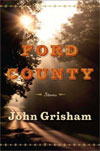
John Grisham and the Short Story
Here are some facts that I know about John Grisham:
- Four of his legal thrillers were made into movies, two of which starred my childhood crush Brad Renfro (may he rest in peace).
- I have seen his books for sale at a CVS in Charlottesville, a Monoprix in Paris and a train station’s waiting area in Tokyo.
- He is very tall in person, and wears very expensive-looking loafers, and has a very lovely Southern accent. This I discovered after having the pleasure of listening to him discuss why he writes fiction when he visited UVa’s MFA workshop.
However, until last month, what I did not know about John Grisham was what his writing was like. I consider myself an avid reader and yet, embarrassingly enough, I had never picked up one of his books. He’s one of the most widely published writers in the world. How had I never picked up a copy of The Pelican Brief or A Time To Kill?
When a package arrived for me one month ago, I looked first at the cover, then at my boyfriend quizzically.
He read the title aloud. “Ford County. Grisham’s doing short stories now. I thought that as a short story writer, you would like them.”
Typically, in an MFA workshop, fiction writers live and breathe the short story. We send out our short stories to literary magazines, and we teach short stories to undergraduates as well (Carver! O’Connor!) with the hope that they, too, will learn to love and embrace the short story like we have. The prospect of writing a novel looms ahead of us, and still, we stubbornly cling to the idea of possibly publishing a short story collection. Agents come to visit, telling us, “it’s all about the novel now. Short stories simply don’t sell.” Over the past few years, literary magazines have been folding faster than kudzu grows. In 2007, Stephen King wrote a riveting essay (“What Ails The Short Story”) in the New York Times Book Review, which he summarized in his closing:
So — American short story alive? Check. American short story well? Sorry, no, can’t say so. Current condition stable, but apt to deteriorate in the years ahead.
What did it mean if John Grisham—the man who has published over twenty books of both fiction and non-fiction—has, for the first time in his career, put out a short story collection? As of today, Ford County is number four on the New York Times bestseller list (a fantastic feat, in my mind, for short stories).
In light of the short story’s steady demise over the past few years, perhaps with signs like Grisham now turning to short stories, this means that it’s time for a comeback. In 2009, short story collections like Wells Towers’s Everything Ravaged, Everything Burned and Maile Meloy’s Both Ways Is The Only Way I Want It were received well by reviewers. Bonnie Jo Campbell’s American Salvage (from Wayne State University Press) was nominated for the National Book Award. And, recently, The Atlantic announced that they will publish short stories directly through the Kindle, a change from their 2005 decision to publish fiction only once a year.
I checked Grisham’s website if there was a direct reason why he switched to short stories, and in his author letter he wrote this: “The good stories stick, but they’re not always long enough to become novels.” The survival of the short story is vital, and I think Grisham’s reason is as good a reason as any.

